Timeline of the 2020 Atlantic hurricane season
The 2020 Atlantic hurricane season was the most active and the seventh costliest Atlantic hurricane season on record. In addition, it was the fifth consecutive above average Atlantic hurricane season from 2016 onward, though it was the first extremely active season since 2017. The season officially began on June 1 and ended on November 30. These dates, adopted by convention, historically describe the period in each year when most Atlantic tropical systems form.[1] However, storm formation is possible at any time of the year, as demonstrated in 2020 with the formation of named storms, Tropical Storm Arthur, and Tropical Storm Bertha on May 16 and May 27 respectively.
| Timeline of the 2020 Atlantic hurricane season | |
|---|---|
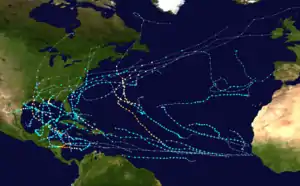 Season summary map | |
| Season boundaries | |
| First system formed | May 16, 2020 |
| Last system dissipated | November 18, 2020 |
| Strongest system | |
| Name | Iota |
| Maximum winds | 160 mph (260 km/h) |
| Lowest pressure | 917 mbar (hPa; 27.08 inHg) |
| Longest lasting system | |
| Name | Paulette |
| Duration | 18 days |
This timeline documents tropical cyclone formations, strengthening, weakening, landfalls, extratropical transitions, and dissipations during the season. It includes information that was not released throughout the season, meaning that data from post-storm reviews by the National Hurricane Center, such as a storm that was not initially warned upon, has been included.
By convention, meteorologists use one time zone when issuing forecasts and making observations: Coordinated Universal Time (UTC), and also use the 24-hour clock (where 00:00 = midnight UTC).[2] In this time line, all information is listed by UTC first with the respective local time included in parentheses.[nb 1]
Timeline
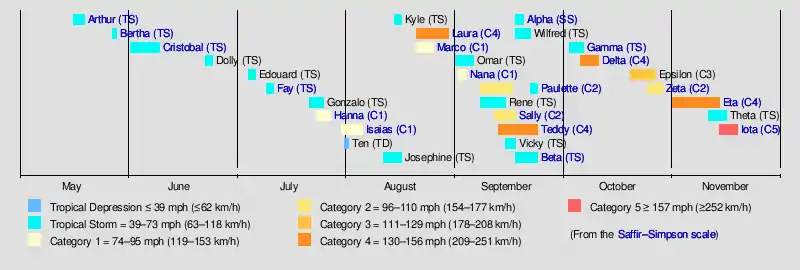
May
May 16
- 18:00 UTC (2:00 p.m. EDT) at 28.0°N 78.7°W – Tropical Depression One forms about 125 mi (200 km)[nb 2] east of Melbourne, Florida.[4]
May 17
- 00:00 UTC (8:00 p.m. EDT May 16) at 28.9°N 78.0°W – Tropical Depression One intensifies into Tropical Storm Arthur approximately 195 mi (305 km) east-northeast of Cape Canaveral, Florida.[4]
May 19

- 06:00 UTC (2:00 a.m. EDT) at 36.8°N 71.4°W – Tropical Storm Arthur reaches its peak intensity with maximum sustained winds of 60 mph (95 km/h) and a minimum barometric pressure of 990 mbar (hPa; 29.23 inHg) about 190 mi (310 km) east-northeast of Cape Hatteras, North Carolina.[4]
- 12:00 UTC (8:00 a.m. AST) at 37.0°N 69.5°W – Tropical Storm Arthur transitions into an extratropical cyclone roughly 380 mi (610 km) northwest of Bermuda.[4]
May 27
- 6:00 UTC (2:00 a.m. EDT) at 31.5°N 78.8°W – Tropical Storm Bertha forms near the South Carolina coast, just 30 mi (50 km) east-southeast of Charleston, South Carolina.[5]
- 12:00 UTC (8:00 a.m. EDT) at 32.6°N 79.5°W – Tropical Storm Bertha reaches its peak intensity with maximum sustained winds of 50 mph (85 km/h) and a central pressure of 1005 mbar (hPa; 29.68 inHg).[5]
- 13:30 UTC (9:30 a.m. EDT) at 32.9°N 79.7°W – Tropical Storm Bertha makes landfall near Isle of Palms, South Carolina, at peak intensity with winds of 50 mph (85 km/h) and a central pressure of 1005 mbar (hPa; 29.68 inHg).[5]
- 18:00 UTC (2:00 p.m. EDT) at 33.7°N 80.1°W – Tropical Storm Bertha weakens to a tropical depression approximately 65 mi (105 km) north-northwest of Charleston, South Carolina.[5]
May 28
- 06:00 UTC (2:00 a.m. EDT) at 37.1°N 81.1°W – Tropical Depression Bertha transitions to an extratropical cyclone roughly 80 mi (130 km) north-northwest of Roanoke, Virginia.[5]
June
June 1
- The 2020 Atlantic hurricane season officially begins.[1]
- 18:00 UTC (1:00 p.m. CDT) at 19.4°N 90.9°W – Tropical Depression Three forms about 50 mi (80 km) west-southwest of Campeche, Mexico.[6]
June 2
- 12:00 UTC (1:00 p.m. CDT) at 19.5°N 92.5°W – Tropical Depression Three intensifies into Tropical Storm Cristobal roughly 155 mi (255 km) west-southwest of Campeche, Mexico.[6]
June 3
- 06:00 UTC (1:00 a.m CDT) at 18.9°N 92.3°W – Tropical Storm Cristobal reaches its peak wind speed with maximum sustained winds of 60 mph (95 km/h).[6]
- 13:00 UTC (8:00 a.m. CDT) at 18.7°N 92.1°W – Tropical Storm Cristobal makes first landfall at Astasa, Campeche, Mexico, at peak wind speed with winds of 60 mph (95 km/h) and a central pressure of 993 mbar (hPa; 29.32 inHg).[6]
June 4
- 15:00 UTC (10:00 a.m. CDT) at 17.6°N 91.0°W – Tropical Storm Cristobal weakens to a tropical depression roughly 160 mi (260 km) south-southwest of Campeche, Mexico.[7]
June 5
- 18:00 UTC (1:00 p.m. CDT) at 20.5°N 89.8°W – Tropical Depression Cristobal strengthens to a tropical storm about 35 mi (60 km) south-southeast of Mérida, Mexico.[8]
June 7
- 22:00 UTC (5:00 p.m. CDT) at 29.3°N 89.8°W – Tropical Storm Cristobal makes second landfall about 50 mi (80 km) south-southeast of New Orleans, Louisiana at peak intensity with winds of 50 mph (85 km/h) and a central pressure of 992 mbar (hPa; 29.29 inHg).[9]
June 8
- 09:00 UTC (4:00 a.m. CDT) at 31.0°N 91.2°W – Tropical Storm Cristobal weakens to a tropical depression about 40 mi (65 km) north of Baton Rouge, Louisiana.[10]
June 10
- 03:00 UTC (10:00 p.m. CDT June 9) at 43.5°N 90.4°W – Tropical Depression Cristobal becomes a post-tropical cyclone about 60 mi (110 km) northwest of Madison, Wisconsin with maximum sustained winds of 35 mph (85 km/h) and a central pressure of 986 mbar (hPa; 29.21 inHg).[11]
June 22
- 21:00 UTC (5:00 p.m. AST) at 38.2°N 65.7°W – Subtropical Depression Four forms about 310 mi (495 km) southeast of Nantucket, Massachusetts.[12]
June 23
- 16:15 UTC (12:15 p.m. AST) at 39.4°N 61.9°W – Subtropical Depression Four transitions to a tropical cyclone, simultaneously intensifies into Tropical Storm Dolly, and reaches its peak intensity with maximum sustained winds of 45 mph (75 km/h) and a minimum barometric pressure of 1002 mbar (hPa; 29.59 inHg) about 370 mi (600 km) south-southeast of Halifax, Nova Scotia.[13]
June 24
- 09:00 UTC (5:00 a.m. AST) at 41.7°N 59.0°W – Tropical Storm Dolly weakens into a tropical depression roughly 450 mi (725 km) southwest of Cape Race, Newfoundland.[14]
- 15:00 UTC (11:00 a.m. AST) at 42.5°N 57.8°W – Tropical Depression Dolly degenerates into a remnant low about 370 mi (595 km) southwest of Cape Race, Newfoundland.[15]
July
July 4
- 15:00 UTC (11:00 a.m. AST) at 31.1°N 68.7°W – Tropical Depression Five forms about 245 mi (390 km) west-southwest of Bermuda.[16]
July 6
- 03:00 UTC (11:00 p.m. AST July 5) at 37.2°N 56.9°W – Tropical Depression Five strengthens into Tropical Storm Edouard about 685 mi (1100 km) south-southwest of Cape Race, Newfoundland.[17]
- 15:00 UTC (11:00 a.m. AST) at 40.8°N 50.0°W – Tropical Storm Edouard reaches a peak intensity with maximum sustained winds of 45 mph (75 km/h) and a minimum barometric pressure of 1007 mbar (29.74 inHg) roughly 435 mi (700 km) south-southeast of Cape Race, Newfoundland.[18]
- 21:00 UTC (5:00 p.m. AST) at 42.7°N 46.0°W – Tropical Storm Edouard becomes post-tropical about 445 mi (715 km) southeast of Cape Race, Newfoundland.[19]
July 9
- 21:00 UTC (5:00 p.m. EDT) at 35.5°N 74.9°W – A complex of thunderstorms associated with a low-pressure area located near the Outer Banks of North Carolina develops into Tropical Storm Fay about 195 mi (310 km) south of Ocean City, Maryland.[20]
July 10
- 21:00 UTC (5:00 p.m. EDT) at 39.5°N 74.3°W – Tropical Storm Fay makes landfall about 10 mi (15 km) north-northeast of Atlantic City, New Jersey, about 90 mi (145 km) south of New York City, with maximum sustained winds of 50 mph (85 km/h) and a minimum central pressure of 998 mbar (29.47 inHg).[21]
July 11
- 06:00 UTC (2:00 a.m. EDT) at 41.5°N 74.0°W – Tropical Storm Fay weakens to a tropical depression while over southeastern New York, roughly 50 mi (80 km) north of New York City.[22]
- 09:00 UTC (5:00 a.m. EDT) at 42.4°N 73.9°W – Tropical Depression Fay degenerates into a post-tropical low about 30 mi (45 km) south of Albany, New York.[23]
July 21
- 21:00 UTC (5:00 p.m. AST) at 9.8°N 40.4°W – Tropical Depression Seven forms about 1185 mi (1905 km) west-southwest of the Cabo Verde Islands.[24]
July 22
- 12:50 UTC (8:50 a.m. AST) at 9.9°N 43.1°W – Tropical Depression Seven intensifies into Tropical Storm Gonzalo about 1290 mi (2075 km) west-southwest of the Cabo Verde Islands.[25]
July 23
- 03:00 UTC (10:00 p.m. CDT, July 22) at 25.9°N 88.2°W – Tropical Depression Eight forms about 530 mi (855 km) east-southeast of Port O'Connor, Texas.[26]
July 24
- 03:00 UTC (10:00 p.m. CDT, July 23) at 26.2°N 91.4°W – Tropical Depression Eight strengthens into Tropical Storm Hanna about 380 mi (610 km) east-southeast of Port O'Connor, Texas.
July 25
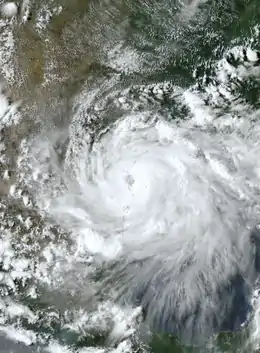
- 12:00 UTC (7:00 a.m. CDT) at 27.1°N 96.0°W – Tropical Storm Hanna intensifies into a Category 1 hurricane about 90 miles east-northeast of Port Mansfield, Texas. [27]
- 18:00 UTC (2:00 p.m. AST) at 10.8°N 61.9°W – Tropical Storm Gonzalo weakens to a tropical depression.
- 21:00 UTC (5:00 p.m. AST) at 11.0°N 63.0°W – Tropical Depression Gonzalo opens up into a tropical wave.
- 22:00 UTC (5:00 p.m. CDT) at 26.8°N 97.4°W – Hurricane Hanna makes landfall about 15 mi (20 km) north of Port Mansfield, Texas, about 70 mi (110 km) south of Corpus Christi, Texas, with maximum sustained winds of 90 mph (150 km/h) and a minimum central pressure of 973 mbar (28.74 inHg).
July 26
- 06:00 UTC (2:00 a.m. EDT) at 26.5°N 98.5°W – Hurricane Hanna weakens to a tropical storm while over southern Texas, roughly 30 mi (50 km) northwest of McAllen, Texas, as its maximum sustained wind speed drops to 70 mph (115 km/h).
- 21:00 UTC (4:00 p.m. CDT) at 25.6°N 100.6°W – Tropical Storm Hanna weakens to a tropical depression while over Northeastern Mexico, roughly 35 mi (55 km) west-southwest of Monterrey, Mexico, as its maximum sustained wind speed drops to 35 mph (55 km/h).
July 28
- 15:00 UTC (11:00 a.m. AST) at 13.8°N 53.7°W – Potential Tropical Cyclone Nine forms about 585 mi (940 km) east-southeast of the Leeward Islands.[28]
July 29
- 03:00 UTC (11:00 p.m. AST) at 15.8°N 67.0°W – Potential Tropical Cyclone Nine organizes into Tropical Storm Isaias about 155 mi (250 km) south of Ponce, Puerto Rico, about 265 mi (430 km) southeast of Santo Domingo, Dominican Republic.[29]
July 30
- 00:00 UTC (8:00 p.m. AST) at 19.9°N 71.2°W – Tropical Storm Isaias makes landfall on the southern coast of Dominican Republic.[30]
- 03:40 UTC (11:40 p.m. AST) at 20.3°N 72.1°W – Tropical Storm Isaias strengthens into a hurricane about 70 mi (110 mi) east-southeast of Great Inagua Island.[31]
July 31
- 21:00 UTC (8:00 p.m. CVT) at 15.9°N 20°W – Tropical Depression Ten forms about 265 mi (430 km) east of the Cabo Verde Islands.[32]
August
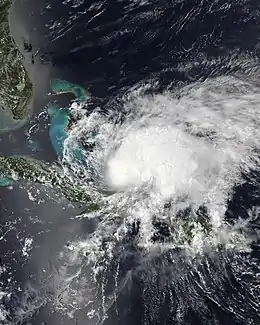
August 1
- 15:00 UTC (11:00 a.m. EDT) at 24.7°N 77.9°W – Hurricane Isaias makes landfall on North Andros Island with maximum sustained winds of 80 mph (130 km/h) and a minimum central pressure of 987 mbar (29.15 inHg).[33]
- 21:00 UTC (5:00 p.m. AST) at 25.1°N 78.7°W – Hurricane Isaias weakens to a tropical storm about 95 mi (155 km) south of Freeport, Bahamas.
August 2
- 03:00 UTC (2:00 a.m. CVT) at 19.5°N 25.0°W – Tropical Depression Ten degenerates into a trough about 250 mi (405 km) north-northwest of the Cabo Verde Islands.[34][35]
August 4
- 03:15 UTC (11:15 p.m. EDT, August 3) at 33.9°N 78.4°W – Hurricane Isaias makes landfall near Ocean Isle Beach, North Carolina with maximum sustained winds of 85 mph (140 km/h) and a minimum central pressure of 988 mb (29.18 inHg).
- 07:00 UTC (3:00 a.m. EDT) at 35.5°N 78.0°W – Hurricane Isaias weakens to a tropical storm about 35 mi (55 km) west-southwest of Greenville, North Carolina and 50 mi (80 km) east-southeast of Raleigh, North Carolina.
August 5
- 03:00 UTC (11:00 p.m. EDT, August 4) at 45.3°N 72.5°W – Tropical Storm Isaias transitions to a post-tropical cyclone about 45 mi (70 km) east-southeast of Montreal, Quebec.
August 11
- 21:00 UTC (5:00 p.m. AST) at 11.7°N 40.0°W – Tropical Depression Eleven forms about 1,110 mi (1,790 km) west-southwest of the Cabo Verde Islands and about 1,450 mi (2,335 km) east of the Lesser Antilles.
August 13
- 15:00 UTC (11:00 a.m. AST) at 13.7°N 49.2°W – Tropical Depression Eleven strengthens into Tropical Storm Josephine about 975 mi (1,565 km) east-southeast of the northern Leeward Islands.
August 14
- 21:00 UTC (5:00 p.m. AST) at 17.8°N 56.1°W – Josephine reaches its lowest pressure of 1004 mbar (29.65 inHg) about 460 mi (740 km) east of the northern Leeward Islands.
- 21:00 UTC (5:00 p.m. EDT) at 37.7°N 71.7°W – Tropical Storm Kyle forms about 185 mi (300 km) southeast of Atlantic City, New Jersey.
August 15
- 15:00 UTC (11:00 a.m. EDT) at 39.0°N 65.6°W – Kyle reaches its peak intensity of maximum sustained winds of 50 mph (85 km/h) and a minimum barometric pressure of 1000 mbar (29.53 inHg) about 360 mi (580 km) east-southeast of Providence, Rhode Island.
August 16
- 09:00 UTC (5:00 a.m. EDT) at 40.0°N 58.9°W – Kyle transitions into a post-tropical cyclone about 545 mi (880 km) southwest of Cape Race, Newfoundland.
- 15:00 UTC (11:00 a.m. AST) at 17.8°N 56.1°W – Josephine weakens to a tropical depression about 195 mi (315 km) northwest of the northern Leeward Islands and about 155 mi (250 km) north-northeast of San Juan, Puerto Rico.
- 21:00 UTC (5:00 p.m. AST) at 20.9°N 65.8°W – Josephine degenerates into a trough of low pressure about 255 mi (410 km) northwest of the northern Leeward Islands and about 175 mi (280 km) north of San Juan, Puerto Rico.
August 20
- 03:00 UTC (11:00 p.m. AST, August 19) at 14.6°N 47.9°W – Tropical Depression Thirteen forms about 1,035 mi (1,670 km) east-southeast of the northern Leeward Islands.
- 15:00 UTC (11:00 a.m. EDT) at 15.1°N 79.7°W – Tropical Depression Fourteen forms about 235 mi (375 km) east of Cabo Gracias a Dios.
August 21
- 13:05 UTC (9:05 a.m. AST) at 17.0°N 59.8°W – Thirteen strengthens into Tropical Storm Laura about 230 mi (375 km) east-southeast of the northern Leeward Islands.
August 22
- 03:00 UTC (11:00 p.m. EDT, August 21) at 18.7°N 84.9°W – Fourteen strengthens into Tropical Storm Marco about 180 mi (290 km) southeast of Cozumel, Mexico.
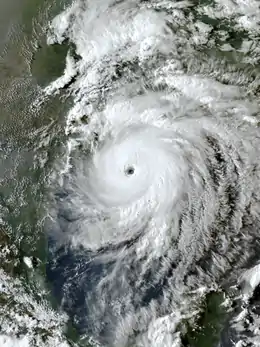
August 23
- 12:00 UTC (8:00 a.m. EDT) at 19.1°N 72.1°W – Tropical Storm Laura makes landfall near San Pedro de Macorís, Dominican Republic with maximum sustained winds of 45 mph (75 km/h) and a minimum central pressure of 1005 mbar (29.68 inHg).
- 16:30 UTC (11:30 a.m. CDT) at 19.1°N 72.1°W – Hurricane Marco reaches its peak intensity with maximum sustained winds of 75 mph (120 km/h) and a minimum central pressure of 991 mbar (29.26 inHg) about 300 mi (480 km) south-southeast of the mouth of the Mississippi River and about 460 mi (740 km) southeast of Lafayette, Louisiana.
August 24
- 00:00 UTC (8:00 p.m. AST, August 23) at 20.0°N 75.6°W – Laura moves over eastern Cuba about 30 mi (55 km) west of Guantánamo, Cuba and about 175 mi (280 km) east-southeast of Camagüey, Cuba.
- 03:00 UTC (10:00 p.m. CDT, August 23) at 26.8°N 87.6°W – Hurricane Marco weakens to a tropical storm about 185 mi (295 km) south-southeast of the mouth of the Mississippi River.
- 23:00 UTC (6:00 p.m. CDT) at 29.0°N 89.2°W – Tropical Storm Marco makes landfall in the Mississippi River delta with winds of 40 mph (65 km/h) and a minimum pressure of 1006 mbar (29.71 inHg).
August 25
- 09:00 UTC (4:00 a.m. CDT) at 28.8°N 91.2°W – Tropical Storm Marco becomes a remnant low about 60 mi (100 km) south of Morgan City, Louisiana and about 110 mi (175 km) south-southeast of Lafayette, Louisiana.
- 12:15 UTC (7:15 a.m. CDT) at 23.4°N 86.4°W – Laura becomes a hurricane about 145 mi (235 km) northwest of the western tip of Cuba and about 625 mi (1005 km) southeast of Lake Charles, Louisiana.
August 26
- 06:00 UTC (1:00 a.m. CDT) at 25.6°N 90.2°W – Hurricane Laura becomes a category 2 hurricane about 360 mi (580 km) south-southeast of Lake Charles, Louisiana and about 380 mi (610 km) southeast of Galveston, Texas.
- 12:00 UTC (7:00 a.m. CDT) at 26.4°N 91.4°W – Hurricane Laura becomes a category 3 major hurricane about 280 mi (450 km) south-southeast of Lake Charles, Louisiana and about 290 mi (465 km) southeast of Galveston, Texas.
- 18:00 UTC (1:00 p.m. CDT) at 27.3°N 92.5°W – Hurricane Laura becomes a category 4 hurricane about 200 mi (320 km) south-southeast of Lake Charles, Louisiana and Port Arthur, Texas.
August 27
- 01:00 UTC (8:00 p.m. CDT, August 26) at 28.7°N 93.1°W – Hurricane Laura reaches its peak intensity with winds of 150 mph (240 km/h) and a minimum pressure of 937 mbar (27.67 inHg) about 95 mi (155 km) south of Lake Charles, Louisiana and south-southeast of Port Arthur, Texas.
- 06:00 UTC (1:00 a.m. CDT) at 29.8°N 93.3°W – Hurricane Laura makes landfall near Cameron, Louisiana with winds of 150 mph (240 km/h) and a slightly risen pressure of 938 mbar (27.70 inHg).
- 09:00 UTC (4:00 a.m. CDT) at 30.5°N 93.4°W – Hurricane Laura weakens to a category 3 hurricane about 30 mi (50 km) north-northwest of Lake Charles, Louisiana and about 50 mi (80 km) northeast Port Arthur, Texas.
- 10:00 UTC (5:00 a.m. CDT) at 30.7°N 93.4°W – Hurricane Laura weakens to a category 2 hurricane about 45 mi (70 km) north-northwest of Lake Charles, Louisiana.
- 14:00 UTC (9:00 a.m. CDT) at 31.7°N 93.1°W – Hurricane Laura weakens to a category 1 hurricane about 65 mi (105 km) south-southeast of Shreveport, Louisiana.
- 17:00 UTC (12:00 p.m. CDT) at 32.6°N 92.9°W – Hurricane Laura weakens to a tropical storm about 50 mi (80 km) east-southeast of Shreveport, Louisiana.
August 28
- 03:00 UTC (10:00 p.m. CDT, August 27) at 35.1°N 92.0°W – Tropical Storm Laura weakens to a tropical depression about 30 mi (50 km) north-northeast of Little Rock, Arkansas.
August 29
- 09:00 UTC (5:00 a.m. EDT) at 38.4°N 83.3°W – Tropical Depression Laura becomes a remnant low about 130 mi (210 km) east of Louisville, Kentucky and about 90 mi (150 km) west of Charleston, West Virginia.
August 31
- 21:00 UTC (5:00 p.m. EDT) at 32.6°N 76.5°W – Tropical Depression Fifteen forms about 190 mi (305 km) south-southwest of Cape Hatteras.
September
September 1
- 15:00 UTC (11:00 a.m. EDT) at 16.1°N 77.5°W – Potential Tropical Cyclone Sixteen forms about 140 mi (225 km) south-southwest of Kingston, Jamaica and about 160 mi (260 km) south-southeast of Negril, Jamaica.
- 16:05 UTC (12:05 a.m. EDT) at 16.5°N 77.7°W – Potential Tropical Cyclone Sixteen strengthens into Tropical Storm Nana about 120 mi (195 km) southwest of Kingston, Jamaica.
- 21:00 UTC (5:00 p.m. AST) at 35.3°N 71.5°W – Tropical Depression Fifteen strengthens into Tropical Storm Omar about 225 mi (365 km) east of Cape Hatteras.
September 2
- 21:00 UTC (5:00 p.m. AST) at 36.1°N 65.7°W – Tropical Storm Omar weakens into a depression about 265 mi (430 km) north of Bermuda.
September 3
- 03:00 UTC (10:00 p.m. CDT) at 17.0°N 87.5°W – Tropical Storm Nana intensifies into a category 1 hurricane about 60 mi (95 km) southeast of Belize City and 80 mi (130 km) northeast of Monkey River Town.
- 05:00 UTC (12:00 a.m. CDT) at 16.8°N 88.3°W – Hurricane Nana makes landfall between Placencia and Dangriga with winds of 75 mph (120 km/h) and a minimum pressure of 995 mbar (29.38 inHg).
- 09:00 UTC (4:00 a.m. CDT) at 16.7°N 88.8°W – Hurricane Nana weakens from a category 1 hurricane to a Tropical Storm about 70 mi (110 km) southwest of Belize City and 35 mi (110 km) northwest of Monkey River Town.
- 21:00 UTC (4:00 p.m. CDT) at 16.0°N 91.1°W – Tropical Storm Nana weakens into a Tropical Depression about 220 mi (350 km) west-southwest of Belize City.
September 4
- 03:00 UTC (10:00 p.m. CDT) at 15.6°N 92.0°W – Tropical Depression Nana becomes a remnant low about 120 mi (195 km) northwest of Guatemala City.
September 5
- 21:00 UTC (5:00 p.m. AST) at 16.0°N 91.1°W – Tropical Depression Omar becomes a remnant low about 610 mi (985 km) northeast of Bermuda.
September 7
- 03:00 UTC (11:00 p.m. AST) at 17.0°N 41.5°W – Tropical Depression Seventeen forms about 1160 mi (1865 km) west of the Cabo Verde Islands and 1425 mi (2290 km) east of the Northern Leeward Islands.
- 09:00 UTC (8:00 a.m. CVT) at 15.2°N 20.3°W – Tropical Depression Eighteen forms about 250 mi (405 km) east-southeast of the Cabo Verde Islands.
- 15:00 UTC (11:00 a.m. AST) at 17.2°N 42.2°W – Tropical Depression Seventeen becomes Tropical Storm Paulette about 1205 mi (1940 km) west of the Cabo Verde Islands and 1375 mi (2215 km) east of the Northern Leeward Islands.
- 21:00 UTC (8:00 p.m. CVT) at 16.1°N 22.3°W – Tropical Depression Eighteen becomes Tropical Storm Rene about 150 mi (180 km) east of the Cabo Verde Islands.

September 8
- 00:00 UTC (11:00 p.m. CVT) at 16.2°N 22.8°W – Tropical Storm Rene makes landfall in Boa Vista with winds of 40 mph (65 km/h) and a minimum pressure of 1001 mbar (29.56 inHg).
September 9
- 03:00 UTC (2:00 a.m. CVT) at 17.0°N 29.3°W – Tropical Storm Rene weakens to a Tropical Depression about 360 mi (575 km) west-northwest of the Cabo Verde Islands.
- 15:00 UTC (11:00 a.m. AST) at 17.6°N 31.5°W – Tropical Depression Rene regains Tropical Storm status about 510 mi (815 km) west-northwest of the Cabo Verde Islands.
September 11
- 21:00 UTC (5:00 p.m. EDT) at 25.4°N 79.0°W – Tropical Depression Nineteen forms about 80 mi (130 km) east-southeast of Miami, Florida.
September 12
- 06:00 UTC (2:00 a.m. EDT) at 25.7°N 80.2°W – Tropical Depression Nineteen makes landfall about 10 mi (15 km) south-southeast of Miami, Florida with winds of 35 mph (55 km/h) and a minimum pressure of 1007 mbar (29.74 inHg).
- 15:00 UTC (11:00 a.m. AST) at 23.2°N 44.4°W – Tropical Storm Rene for the second time weakens to a Tropical Depression about 1415 mi (2275 km) west-northwest of the Cabo Verde Islands and 1255 mi (2020 km) east-northeast of the Northern Leeward Islands.
- 18:00 UTC (2:00 p.m. EDT) at 25.6°N 81.6°W – Tropical Depression Nineteen becomes Tropical Storm Sally about 35 mi (60 km) south-southeast of Naples, Florida
- 21:00 UTC (5:00 p.m. AST) at 11.4°N 33.5°W – Tropical Depression Twenty forms about 2030 mi (3265 km) east of the Northern Leeward Islands.
September 13
- 03:00 UTC (11:00 p.m. AST) at 28.9°N 59.7°W – Tropical Storm Paulette becomes a category 1 hurricane about 385 mi (615 km) southeast of Bermuda.
September 14
- 09:00 UTC (5:00 a.m. AST) at 32.3°N 64.7°W – Hurricane Paulette makes landfall on the Island of Bermuda with winds of 90 mph (150 km/h) and a minimum pressure of 973 mbar (28.73 inHg).
- 09:00 UTC (5:00 a.m. AST) at 13.4°N 40.4°W – Tropical Depression Twenty becomes Tropical Storm Teddy about 1110 mi (1785 km) west of the Cabo Verde Islands and 1405 mi (2260 km) east of the Lesser Antilles.
- 10:00 UTC (9:00 a.m. CVT) at 18.5°N 28.3°W – Tropical Depression Twenty-One forms about 330 mi (535 km) west-northwest of the Cabo Verde Islands.
- 13:00 UTC (9:00 a.m. AST) at 33.1°N 65.0°W – Hurricane Paulette becomes a category 2 hurricane about 55 mi (90 km) north-northwest of Bermuda.
- 15:00 UTC (2:00 a.m. CVT) at 18.7°N 28.5°W – Tropical Depression Twenty-One becomes Tropical Storm Vicky about 350 mi (565 km) west-northwest of the Cabo Verde Islands.
- 16:00 UTC (11:00 a.m. CDT) at 28.6°N 86.9°W – Tropical Storm Sally becomes a category 1 hurricane about 135 mi (220 km) east-southeast of the mouth of the Mississippi River and 175 mi (280 km) southeast of Biloxi, Mississippi.
- 21:00 UTC (5:00 p.m. AST) at 26.9°N 49.3°W – Tropical Depression Rene becomes a remnant low about 1045 mi (1685 km) northeast of the Leeward Islands.
- 21:00 UTC (4:00 p.m. CDT) at 28.8°N 87.4°W – Hurricane Sally becomes a category 2 hurricane about 105 mi (170 km) east of the mouth of the Mississippi River and 145 mi (230 km) southeast of Biloxi, Mississippi.
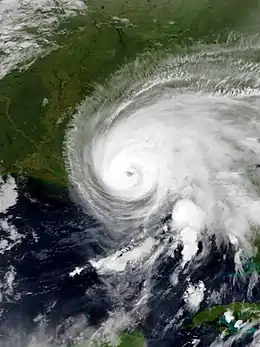
September 15
- 06:00 UTC (1:00 a.m. CDT) at 28.8°N 88.0°W – Hurricane Sally weakens to a category 1 hurricane about 75 mi (120 km) east-southeast of the mouth of the Mississippi River and 115 mi (190 km) south-southeast of Biloxi, Mississippi.
September 16
- 05:00 UTC (12:00 a.m. CDT) at 29.8°N 87.8°W – Hurricane Sally restrengthens to a category 2 hurricane about 65 mi (105 km) south-southeast of Mobile, Alabama and 60 mi (85 km) southwest of Pensacola, Florida.
- 06:10 UTC (2:10 a.m. AST) at 15.4°N 48.5°W – Tropical Storm Teddy becomes a category 1 hurricane about 830 mi (1335 km) east of the Lesser Antilles.
- 10:00 UTC (5:00 a.m. CDT) at 30.3°N 87.7°W – Hurricane Sally makes landfall as a category 2 hurricane near Gulf Shores, Alabama with winds of 105 mph (165 km/h) and a minimum pressure of 965 mbar (28.50 inHg).
- 13:00 UTC (8:00 a.m. CDT) at 30.5°N 87.6°W – After making landfall, Hurricane Sally weakens to a category 1 hurricane about 20 mi (30 km) north-northeast of Gulf Shores, Alabama and 25 mi (40 km) west of Pensacola, Florida.
- 15:00 UTC (11:00 a.m. AST) at 43.3°N 45.2°W – Hurricane Paulette becomes a Post-Tropical Cyclone about 450 mi (725 km) east-southeast of Cape Race, Newfoundland.
- 18:00 UTC (1:00 p.m. CDT) at 30.9°N 87.1°W – Hurricane Sally weakens to a Tropical Storm about 30 mi (45 km) north-northeast of Pensacola, Florida.
September 17
- 03:00 UTC (10:00 p.m. CDT) at 31.9°N 86.1°W – Tropical Storm Sally weakens to a Tropical Depression about 30 mi (50 km) south-southheast of Montgomery, Alabama.
- 09:00 UTC (5:00 a.m. AST) at 18.3°N 52.3°W – Hurricane Teddy becomes a category 2 hurricane about 625 mi (1010 km) east-northeast of the Lesser Antilles.
- 15:00 UTC (11:00 a.m. AST) at 21.4°N 38.2°W – Tropical Storm Vicky weakens to a Tropical Depression about 1000 mi (1610 km) west-northeast of the Cabo Verde Islands.
- 15:00 UTC (11:00 a.m. AST) at 19.3°N 53.0°W – Hurricane Teddy becomes a category 3 major hurricane about 610 mi (980 km) east-northeast of the Lesser Antilles and 1155 mi (1865 km) southeast of Bermuda.
- 15:00 UTC (11:00 a.m. AST) at 32.6°N 84.4°W – Tropical Depression Sally becomes a Post-Tropical cyclone about 115 mi (185 km) southwest of Athens, Georgia.
- 21:00 UTC (5:00 p.m. AST) at 19.3°N 53.0°W – Tropical Depression Vicky becomes a remnant low about 1050 mi (1690 km) west-northeast of the Cabo Verde Islands.
- 21:00 UTC (5:00 p.m. AST) at 20.1°N 54.1°W – Hurricane Teddy becomes a category 4 major hurricane about 575 mi (925 km) northeast of the Lesser Antilles and 1070 mi (1725 km) southeast of Bermuda.
- 22:00 UTC (6:00 p.m. CDT) at 21.9°N 94.3°W – Tropical Depression Twenty-Two forms about 230 mi (370 km) east of Tampico, Mexico and 330 mi (535 km) southeast of the mouth of the Rio Grande.
September 18
- 15:00 UTC (11:00 a.m. AST) at 11.9°N 32.4°W – Tropical Storm Wilfred forms 630 mi (1015 km) west-southwest of the Cabo Verde Islands.
- 16:30 UTC (4:30 p.m. GMT) at 39.9°N 9.3°W – Subtropical Storm Alpha forms 75 mi (125 km) north of Lisbon, Portugal.
- 21:00 UTC (5:00 p.m. AST) at 19.3°N 53.0°W – Hurricane Teddy weakens to a category 3 major hurricane about 520 mi (835 km) northeast of the northern Leeward Islands and 795 mi (1275 km) southeast of Bermuda.
- 21:00 UTC (9:00 p.m. GMT) at 19.3°N 53.0°W – Subtropical Storm Alpha makes a rare landfall near Lisbon, Portugal with winds of 45 mph (75 km/h) and a minimum pressure of 998 mbar (29.47 inHg).
- 21:00 UTC (4:00 p.m. CDT) at 24.3°N 93.1°W – Tropical Depression Twenty-Two becomes Tropical Storm Beta about 335 mi (545 km) east-northeast of Tampico, Mexico and 280 mi (450 km) east-southeast of the mouth of the Rio Grande.
October
October 2
- 15:00 UTC (11:00 a.m. CDT) at 18.1°N 84.7°W – Tropical Depression Twenty-Five forms about 220 mi (355 km) southeast of Cozumel, Mexico. [36]
October 3
- 00:00 UTC (7:00 p.m. CDT) at 18.8°N 85.8°W – Tropical Depression Twenty-Five strengthens into Tropical Storm Gamma about 135 mi (220 km) south-southeast of Cozumel, Mexico. [37]
Notes
- Five such time zones are utilized in the basin: Cape Verde Time for systems south of 25°N and east of 30°W, Greenwich Mean Time north of 25°N and east of 45°W, Eastern Time between 70°W and 85°W, Central Time between 85°W and 100°W, and Atlantic Time in the remainder of the basin.[3]
- The figures for maximum sustained winds and position estimates are rounded to the nearest 5 units (knots, miles, or kilometers), following the convention used in the National Hurricane Center's operational products for each storm. All other units are rounded to the nearest digit.
References
- Dorst, Neal (June 1, 2018). "Hurricane Season Information". Frequently Asked Questions About Hurricanes. Miami, Florida: NOAA Atlantic Oceanographic and Meteorological Laboratory. Retrieved June 29, 2020.
- "Understanding the Date/Time Stamps". miami, Florida: NOAA National Hurricane Center. Retrieved July 10, 2020.
- "Update on National Hurricane Center Products and Services for 2020" (PDF). Miami, Florida: National Hurricane Center. April 20, 2020. Retrieved May 17, 2020.
- Latto, Andy (September 10, 2020). Tropical Storm Arthur (PDF) (Report). Miami, Florida: NWS National Hurricane Center. Retrieved February 2, 2020.
- Cangialosi, John (September 23, 2020). Tropical Storm Bertha (PDF) (Report). Miami, Florida: NWS National Hurricane Center. Retrieved February 4, 2021.
- Berg, Robbie (January 13, 2021). Tropical Storm Cristobal (PDF) (Report). Miami, Florida: NWS National Hurricane Center. Retrieved February 5, 2021.
- Pasch, Richard (June 4, 2020). Tropical Depression Cristobal Public Advisory Number 12 (Report). Miami, Florida: NWS National Hurricane Center. Retrieved June 4, 2020.
- Pasch, Richard (June 5, 2020). Tropical Storm Cristobal Intermediate Advisory Number 16A (Report). Miami, Florida: NWS National Hurricane Center. Retrieved June 6, 2020.
- Brown, Daniel; Latto, Andrew (June 7, 2020). Tropical Storm Cristobal Tropical Cyclone Update (Report). Miami, Florida: NWS National Hurricane Center. Retrieved June 7, 2020.
- Beven, Jack (June 8, 2020). Tropical Depression Cristobal Advisory Number 27 (Report). Miami Florida: NWS National Hurricane Center. Retrieved June 25, 2020.
- Burke, Patrick C. (June 9, 2020). Post-Tropical Cyclone Cristobal Advisory Number 34 (Report). College Park, Maryland: NWS Weather Prediction Center. Retrieved June 10, 2020.
- Stewart, Stacy (June 22, 2020). Subtropical Depression Four Public Advisory Number 1 (Report). Miami, Florida: NWS National Hurricane Center. Retrieved June 24, 2020.
- Stewart, Stacy (June 23, 2020). Tropical Storm Dolly Tropical Cyclone Update (Report). Miami, Florida: NWS National Hurricane Center. Retrieved June 24, 2020.
- Latto, Andrew (June 24, 2020). Tropical Depression Dolly Public Advisory Number 8 (Report). Miami, Florida: NWS National Hurricane Center. Retrieved June 24, 2020.
- Latto, Andrew (June 24, 2020). Post-Tropical Cyclone Dolly Public Advisory Number 9 (Report). Miami, Florida: NWS National Hurricane Center. Retrieved June 24, 2020.
- Zelinsky, David (July 4, 2020). Tropical Depression Five Public Advisory Number 1 (Report). Miami, Florida: National Hurricane Center. Retrieved July 6, 2020.
- Blake, Eric (July 5, 2020). Tropical Storm Edouard Public Advisory Number 7 (Report). Miami, Florida: National Hurricane Center. Retrieved July 6, 2020.
- Brown, Daniel (July 6, 2020). Tropical Storm Edouard Public Advisory Number 9 (Report). Miami, Florida: National Hurricane Center. Retrieved July 7, 2020.
- Zelinsky, David (July 6, 2020). Post-Tropical Cyclone Edouard Public Advisory Number 10 (Report). Miami, Florida: National Hurricane Center. Retrieved July 7, 2020.
- Brown, Daniel (July 9, 2020). Tropical Storm Fay Public Advisory Number 1 (Report). Miami, Florida: National Hurricane Center. Retrieved July 9, 2020.
- Brennan, Michael (July 10, 2020). Tropical Storm Fay Public Advisory Number 6 (Report). Miami, Florida: National Hurricane Center. Retrieved July 10, 2020.
- Pasch, Richard (July 11, 2020). Tropical Depression Fay Intermediate Advisory Number 7A (Report). Miami, Florida: National Hurricane Center. Retrieved July 11, 2020.
- Pasch, Richard (July 11, 2020). Post-Tropical Cyclone Fay Public Advisory Number 8 (Report). Miami, Florida: National Hurricane Center. Retrieved July 11, 2020.
- Jack Beven (July 21, 2020). Tropical Depression Seven Public Advisory Number 1 (Report). Miami, Florida: National Hurricane Center. Retrieved July 21, 2020.
- Jack Beven. "Tropical Storm GONZALO Update Statement". www.nhc.noaa.gov. Retrieved 2020-11-17.
- Cangialosi, John P. (July 22, 2020). Tropical Depression Eight Public Advisory Number 1 (Report). Miami, Florida: National Hurricane Center. Retrieved July 23, 2020.
- Stewart, Stacy R. "Hurricane HANNA Public Advisory 10A". www.nhc.noaa.gov. Retrieved 2020-11-17.
- Jack Beven (July 28, 2020). Potential Tropical Cyclone Nine Public Advisory Number 1 (Report). Miami, Florida: National Hurricane Center. Retrieved July 30, 2020.
- Pasch, Richard (July 29, 2020). Tropical Storm Isaias Public Advisory Number 7 (Report). Miami, Florida: National Hurricane Center. Retrieved July 30, 2020.
- Pasch, Richard (July 30, 2020). Tropical Storm Isaias Public Advisory Number 10A (Report). Miami, Florida: National Hurricane Center. Retrieved July 30, 2020.
- Blake, Eric (July 30, 2020). Tropical Storm Isaias Tropical Cyclone Update (Report). Miami, Florida: National Hurricane Center. Retrieved July 30, 2020.
- Daniel Brown (July 31, 2020). Tropical Depression Ten Public Advisory Number 1 (Report). Miami, Florida: National Hurricane Center. Retrieved September 17, 2020.
- Stacy R. Stewart (August 1, 2020). "Hurricane Isaias Discussion Number 4". www.nhc.noaa.gov. Miami, Florida: National Hurricane Center. Retrieved August 1, 2020.
- Andrew Latto (August 1, 2020). "Tropical Depression Ten Discussion Number 4". www.nhc.noaa.gov. Miami, Florida: National Hurricane Center. Retrieved August 1, 2020.
- David Zelinsky (August 2, 2020). "Remnants of Ten Discussion Number 6". www.nhc.noaa.gov. Miami, Florida: National Hurricane Center. Retrieved August 2, 2020.
- Pasch, Richard. "Tropical Depression Twenty-Five Advisory Number 1". nhc.noaa.gov. Retrieved December 30, 2020.
- Cagialosi, John. "Tropical Storm Gamma Intermediate Advisory Number 2A". nhc.noaa.gov. Retrieved December 30, 2020.
External links
| Wikimedia Commons has media related to 2020 Atlantic hurricane season. |